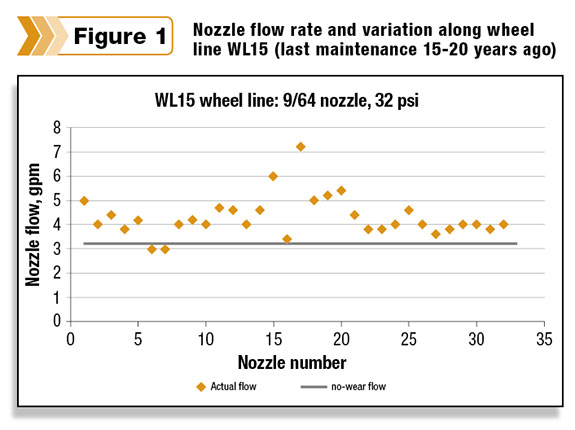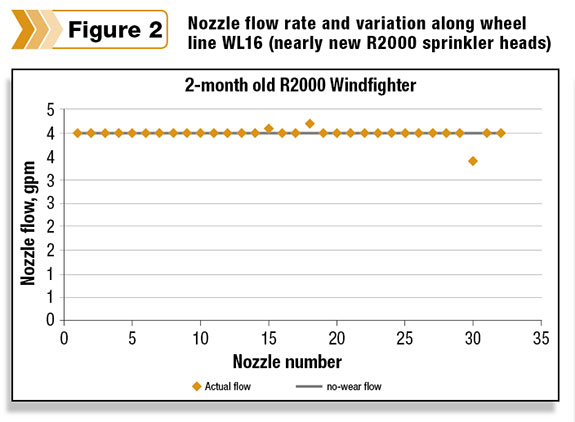Given the current snowpack water content and the uncertainty of forecasting future snow accumulation, this looks like a year to manage early-season irrigation carefully to make best use of limited water.
Water management
Both alfalfa and corn benefit from adequate early-season soil moisture. In alfalfa, adequate water as the crop is breaking dormancy leads to more early vigor and plant growth.
In southern Idaho, each inch of water applied before first cutting will produce about 510 poundss of hay, with production of about 400 poundss per inch after first cutting.
Early-season water stress in corn, particularly around V6-V7 stages, will reduce ear size and number of kernels per ear. The other critical crop stage where stress significantly reduces yield is during pollination.
A new University of Idaho publication, “Center Pivot Irrigation for Corn: Water Management and System Design Considerations in Southern Idaho” by Steve Hines and Howard Neibling, will be available online through University of Idaho Extension Publications.
This publication discusses a number of design and management ideas to better use limited water. Most of the system design ideas apply equally well to either corn or alfalfa.
Irrigation system maintenance
Another study conducted by University of Idaho personnel for Idaho Power last summer measured the number and size of different types of leaks and the degree of nozzle wear in sprinkler irrigation systems.
Over 30 set system lines were tested. Average measured water lost to pipe, sprinkler and drain valve leaks in wheel lines was 12 to 16 percent of the line design flow. Losses for hand lines were even higher.

Flow from over 900 sprinkler heads was also measured. Individual nozzle discharge for an older line needing maintenance and a line with nearly new sprinkler heads is shown in Figure 1.
Note the variability in the older system and the degree of excess nozzle flow in the older system.
Excess line flow due to worn or incorrect nozzle size averaged 13 percent of design flow.
Average excess energy use due to incorrect nozzle size or worn nozzles was 151kWh per acre. To put this in perspective, consider a 1,300-foot line on 40’ x 50’ spacing (50-foot moves) which would cover about 1.5 acres per set.
If this line was moved 10 times per irrigation, the total area covered would be 15 acres. At $0.069 per kWh electricity cost, the average cost per line of the extra water pumped due to worn nozzles would be $125 per year.
Adding in the cost of pumping extra water due to leaks of $200 per line per irrigation, the average total cost of leaks and worn nozzles for the lines tested would be $325 per line per irrigation.
The total excess water pumped (about 27 percent of design flow) represents a great deal of water applied in locations in excess of what was needed.
This typically leads to local areas of nitrate loss to leaching, areas of fungal disease initiation and a large amount of water that could be used effectively somewhere else when water supply is short.
Uniformity of water application was also measured for a number of center pivot systems.
Catch containers were placed at 10-foot intervals along a radial line in front of the advancing pivot.
Depth of water collected at each location was recorded. An industry-standard measure of system uniformity (coefficient of uniformity or CU) was calculated for each pivot tested.
Test results for about 30 pivots ranged from 69 to 94 percent.
A value in the low 90s is generally considered the best level of uniformity that can actually be achieved in the field. Values of CU less than 85 percent (about 60 percent of the pivots tested in this study) indicate that the system application package needs significant maintenance or replacement.

Figure 2 shows visually the difference in uniformity of water application for pivots with CU= 93 and CU=77.
Careful irrigation management to apply the correct amount of water at the correct time will most effectively utilize limited water to give best crop yield and quality.
Correction of leaks and worn nozzle problems in both set and center pivot systems can be fixed with routine system maintenance and will allow limited water supplies to be better utilized.
Cost-share funding is available from Idaho Power to help pay for the component updates, which will result in significant water and energy savings, reduction in disease potential and reduced labor requirements. FG












